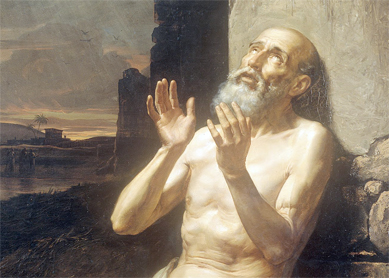Job, the beleaguered man of impeccable moral character in the book that bears his name, is most often depicted by artists as half-naked atop a garbage heap, covered with sores, surrounded by three friends and his wife. In some works, Job patiently endures his pain, but in others he screams at God. Job’s wife and friends either berate him or they sit in supportive silence, as in the fresco at Parz Castle.
Why would artists depict Job so differently? The poetry in book of Job is often difficult to interpret, so artists have a wide range of options when depicting the story. Job’s friends are caring and kind (
Since Job speaks often of his own mortality (
Images of Job often include details found in nonbiblical sources. For example, in the Qur’an, Job only suffers patiently; eventually God commands Job to strike his foot on the ground, producing a spring of water to rise and restore him (sura 21). Later Muslim traditions expand upon this story, and many of these details are represented in Muslim art. Likewise, details from extrabiblical Jewish and Christian legends of Job, including the intriguing connection between Job and musicians, appear frequently in Western art. Many medieval legends about Job derive from the ancient Jewish folktale called the Testament of Job, likely written in the first century B.C.E., which describes Job playing music to entertain his servants and giving musical instruments to his daughters.
In the Rothschild Miscellany, an enormous illuminated manuscript commissioned by a Jewish patron, Job is a wealthy Renaissance merchant. In the late fifteenth century C.E., Italian Jews flourished during a brief period of relative political favor. This image of Job thus reflects a successful Jewish community that nonetheless admits to previous—and future—suffering.
In the modern era, artists often grapple with radical elements in the book of Job, from God’s seeming indifference to Job’s suffering to Job’s questioning of divine justice. In response to the horrors of the twentieth century, in particular the Holocaust, many artists have used the figure of Job to express anger and rebellion in the face of undeserved, extreme suffering. This anger and despair, often accompanied by spiritual doubt, are reflected in the drawings of Marc Chagall, the woodcuts of Jakob Steinhardt, the paintings of Francis Gruber, and the sculptures of Gerhard Marcks and Ivan Meštrovi.
Bibliography
- Terrien, Samuel. The Iconography of Job through the Centuries: Artists as Biblical Interpreters. University Park: Pennsylvania State University Press, 1996.
- Vicchio, Stephen J. The Image of the Biblical Job: A History. 3 vols. Eugene. Ore.: Wipf & Stock, 2006.
- Besserman, Lawrence. The Legend of Job in the Middle Ages. Cambridge, Mass.: Harvard University Press, 1979.





